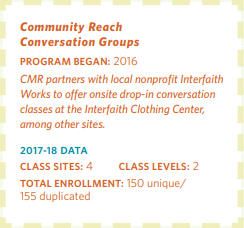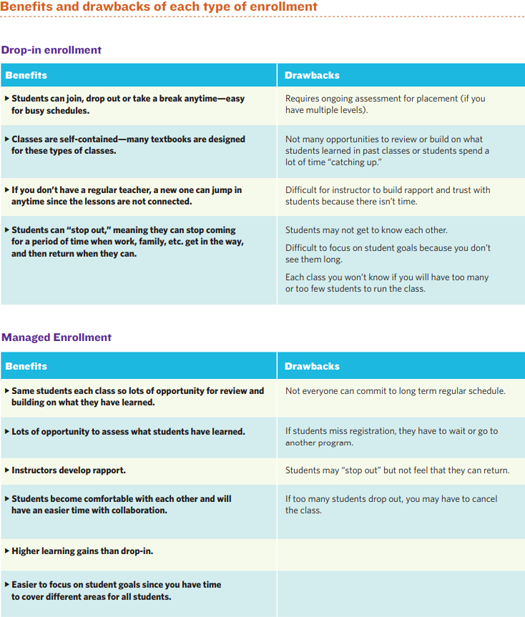-
Program
Administrator
ToolkitA Guide to Implementing and Managing Community-Based Adult ESOL Classes and Programs
-
You are here
Chapter 3: Drop-in vs. Managed Enrollment
Fundamental Considerations Chapter 3
Drop-in vs. Managed Enrollment
♦ PRACTICE EXAMPLES
 Ana. A. Brito Foundation
Ana. A. Brito Foundation
Marta Brito Perez, former PresidentEnglish Literacy Program
ESOL INSTRUCTION BEGAN: 1985
The Ana A Brito Foundation was founded in 2014 to support the growth of existing English and computer classes at Epworth United Methodist Church in Gaithersburg.
2017–18 DATA
CLASS SITES: 1 CLASS LEVELS: 5 TOTAL ENROLLMENT: 159 unique/260 duplicated“In 1985 the Language and Computer program started as an informal program and has evolved into an important dimension of services upon which the local immigrant community relies. To respond to continued learner demand, we increased the number of ESOL levels, and added computer classes and support services over the years. We have also added more structure to the ESOL classes, to better enable students to reach their goals, whether it be communicating in English better at school, with doctors, or at their place of work. An ongoing challenge to the program and the ability of students to advance to higher levels has been the inconsistency of attendance. The program began as an informal drop-in program with no strict attendance policy. In 2015 the foundation was able to transition to managed enrollment with two entry points during the school year, fall and spring. For those students who wished to start ESOL learning mid-semester, the program added an informal bridge class that followed the basic class curriculum, which they could attend until the beginning of the next semester. While there are still those who are not able to consistently attend class, those who do attend regularly are able to make remarkable progress and are more likely to achieve the goals they have set for themselves. On occasion, if a student comes in the middle of the semester, we may place them in the immediate level below where they test so that they can start taking classes and don’t have to wait a full semester before starting.”
Students starting mid-semester take an informal bridge class that follows the basic curriculum
♦ NOTES FROM THE FIELD
 CASA has been offering drop-in classes for a number of years at their sites for day-labor workers to improve their Engish while they wait for possible positions. Community Education Manager Shannon Wilk and ESOL Coordinator Rebecca Cusic offer some suggestions for what makes their program a success. Learn More >>
CASA has been offering drop-in classes for a number of years at their sites for day-labor workers to improve their Engish while they wait for possible positions. Community Education Manager Shannon Wilk and ESOL Coordinator Rebecca Cusic offer some suggestions for what makes their program a success. Learn More >>
Cecilia Rojas, Program Manager of the Language Outreach Program (LOP) for Community Reach, explains an innovative drop-in conversation group approach started in 2016 to enhance their larger LOP managedenrollment ESOL program. Learn More >>



 No. Some programs are set up as managed enrollment to help learners make steady progress. But rather than make students wait until the next session, programs will test students as they show up and let them enter mid-session. George B. Thomas, Learning Academy (GBTLA) has chosen to have rolling, or open, admission for its English classes for parents of children who attend its Saturday School programs at public schools in Montgomery County. For GBTLA, offering parents the opportunity to improve their English skills is an important part of encouraging and preparing them to become more engaged in their children’s education within the Montgomery County Public Schools. Rolling admission allows the program to support any parents who are willing to learn but may have other commitments that do not enable them to attend regularly.
No. Some programs are set up as managed enrollment to help learners make steady progress. But rather than make students wait until the next session, programs will test students as they show up and let them enter mid-session. George B. Thomas, Learning Academy (GBTLA) has chosen to have rolling, or open, admission for its English classes for parents of children who attend its Saturday School programs at public schools in Montgomery County. For GBTLA, offering parents the opportunity to improve their English skills is an important part of encouraging and preparing them to become more engaged in their children’s education within the Montgomery County Public Schools. Rolling admission allows the program to support any parents who are willing to learn but may have other commitments that do not enable them to attend regularly.